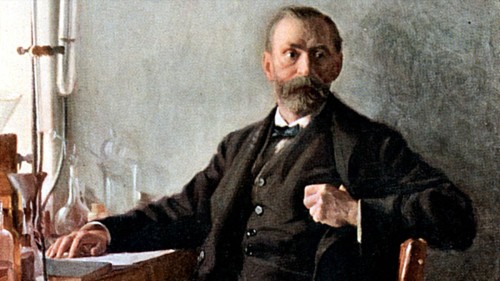He lost his brother in an explosion during an experiment: the story of Alfred Nobel
The Nobel Prizes are prestigious awards given by the association established by the will of Alfred Nobel, aiming to reward those who serve humanity, and the first awards were given in 1901.

Alfred Nobel was known for his ability to combine the intellect and skill of inventors and scientists with the dynamism of industrialists and manufacturers. Nobel was also closely involved with social and peace-related issues. Nobel, who was also interested in literature, also wrote poetry and theater plays. In this context, the Nobel Prizes can be defined as an extension of Nobel's versatile personality, personal interests and life.
Born in Stockholm in 1833, Nobel was very interested in literature and poetry as well as chemistry and physics. His father, who was an engineer, did not like his interest in literature and poetry and sent Alfred to different countries, enabling him to improve himself in the field of chemistry. He started working in a private laboratory with the famous chemist Professor T. J. Pelouze in Paris, one of the cities he went to. There he met a young chemist named Ascanio Sobrero, who discovered nitroglycerin, a dangerous and explosive liquid. Nitroglycerin, a mixture of sulfuric and nitric acid, was too dangerous to have any practical use. Because in any case, the probability of explosion was very high when faced with heat or pressure. During this period, Alfred Nobel started to work on how to use nitroglycerin in a practical way, especially in the field of construction. However, he was also aware that the safety problems that would arise during the use and detonation of this substance had to be solved.
Returning to his family in 1852 to help with his family's business, Nobel continued to experiment with the use of nitroglycerin with his father. After going to Sweden in 1863, he continued his studies on the explosive side of nitroglycerin. However, the results of this work began to be quite painful. Many explosions took place during these studies. In the explosion of 1864, his brother Emil and many others were killed. After these events, the use of nitroglycerin was found dangerous by the authorities and banned within the city limits of Stockholm. But none of this discouraged Nobel, and Nobel began mass production of nitroglycerin. In order to ensure a safer use of this substance, Nobel tried to use different additives. His mixture with kieselguhr material made the liquid a paste-like consistency, making it easier to insert the substance into the boreholes.
This mixture was patented by Nobel in 1867 under the name of dynamite. However, Nobel invented the detonator so that the dynamite could be detonated. These inventions coincided with the widespread use of diamond bit drilling and air drilling, thereby reducing the cost of many construction jobs such as rock blasting, tunneling, canal construction.
Growing his business in a short time, Nobel started exporting nitroglycerin explosives to Europe, America and Australia from his factory in Krimmel near Hamburg in 1865. Over the years, it has established factories and laboratories in more than 90 places and more than 20 countries. Nobel, who was involved in many chemical inventions such as rayon, synthetic rubber and synthetic leather, in addition to the development of explosive technology when he was not involved in business, was the owner of 355 patents when he died in 1896.
The testament of Nobel, who died in San Remo, Italy on December 10, 1896, is a reflection of his life view; His wealth was to be used for prizes in physics, chemistry, psychology, medicine, literature, and peace.
It is a sad misfortune that Nobel, who bequeathed the Nobel Peace Prizes after his death, could not foresee that the dynamite he had invented for use in construction works could later be used in anti-peace actions.
